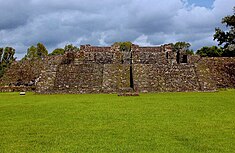
Back Spaanse verowering van die Asteekse Ryk Afrikaans الغزو الإسباني لإمبراطورية الآزتك Arabic Conquista de Méxicu AST آزتک ایمپراتورلوغونون ایسپانیوللار طرفیندن آلینماسی AZB Завладяване на Ацтекската империя Bulgarian Conquesta de l'Imperi Asteca Catalan Dobývání Aztécké říše Czech Spanische Eroberung Mexikos German Konkero de Meksiko Esperanto Conquista de México Spanish
| Spanish conquest of the Aztec Empire | |||||||||
|---|---|---|---|---|---|---|---|---|---|
| Part of the Spanish colonization of the Americas and Mexican Indian Wars | |||||||||
 Conquest of Mexico by Cortés, oil on canvas[1] Spanish: Conquista de México por Cortés | |||||||||
| |||||||||
| Belligerents | |||||||||
Indigenous allies:
Support or occasional alliesb: |
Aztec Triple Alliance (1519–1521) Allied city-states: Independent kingdoms and city-states:
Governorate of Cuba (1520, see) | ||||||||
| Commanders and leaders | |||||||||
|
Spanish commanders:
Indigenous allies:
|
Aztec commanders:
| ||||||||
| Strength | |||||||||
|
Spaniards (total):
~10,000 Totonac (~8,400 followed Cortés from Cempoala) and high number of other indigenous allies | |||||||||
| Casualties and losses | |||||||||
|
1,800 Spaniards dead[2] Tens of thousands of Tlaxcaltecs and indigenous allies dead[citation needed] |
200,000 Aztecs dead (including civilians)[3]
Unknown casualties of other natives 15 Spaniards dead, many wounded at the Battle of Cempoala (1520) | ||||||||
| 10,500,000 deaths as a result of the conquest (87.5% of the population of the modern day territory of Mexico)[6] | |||||||||
| |||||||||
| Aztec civilization |
|---|
 |
| Aztec society |
| Aztec history |
The Spanish conquest of the Aztec Empire was a pivotal event in the history of the Americas, marked by the collision of the Aztec Triple Alliance and the Spanish Empire. Taking place between 1519 and 1521, this event saw the Spanish conquistador Hernán Cortés, and his small army of European soldiers and numerous indigenous allies, overthrowing one of the most powerful empires in Mesoamerica.
Led by the Aztec ruler Moctezuma II, the Aztec Empire had established dominance over central Mexico through military conquest and intricate alliances. Because the Aztec Empire ruled via hegemonic control by maintaining local leadership and relying on the psychological perception of Aztec power—backed by military force—the Aztecs normally kept subordinate rulers compliant. This was an inherently unstable system of governance, as this situation could change with any alteration in the status quo.[7] A combination of factors including superior weaponry, strategic alliances with oppressed or otherwise dissatisfied or opportunistic indigenous groups, and the impact of European diseases contributed to the downfall of the short rule of the Aztec civilization.
The invasion of Tenochtitlán, the capital of the Aztec Empire, marked the beginning of Spanish dominance in the region and the establishment of New Spain. This conquest had profound consequences, as it led to the cultural assimilation of the Spanish culture, while also paving the way for the emergence of a new social hierarchy dominated by Spanish conquerors and their descendants.
- ^ "Indigeniso e hispanismo". Arqueología mexicana. Archived from the original on 4 March 2016. Retrieved 20 October 2015. (Spanish)
- ^ a b Thomas, Hugh. Conquest: Montezuma, Cortes, and the Fall of Old Mexico, (New York: Simon and Schuster, 1993), 528–529.
- ^ a b c Clodfelter 2017, p. 32.
- ^ Diaz, B., 1963, The Conquest of New Spain, London: Penguin Books, ISBN 0140441239: states that Cortes's men lost all the artillery they had initially arrived with during La Noche Triste.
- ^ Bernard Grunberg, "La folle aventure d'Hernan Cortés", in L'Histoire n°322, July–August 2007: states that Cortes arrived in Mexico with 15 cannons, before acquiring the forces of Pánfilo de Narváez.
- ^ Borah/Cook 1989: "El pasado de México: aspectos sociodemográficos" 218-219
- ^ Ross Hassig (1988). Aztec Warfare: Imperial Expansion and Political Control. University of Oklahoma Press, 1988. p. 25. ISBN 9780806121215. Retrieved 6 September 2024.